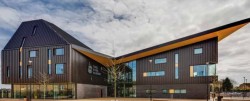According to former US President Bill Clinton, 'the price of doing the same old thing is far higher than the cost of change.' Andrew Orriss, STA Assure Director for the Structural Timber Association (STA), discusses the organisations transformational journey and why adapting to change is crucial for those in the construction sector.
Competency and compliance are not often considered the most scintillating of subjects and at a time when the construction industry is going through a period of unprecedented change, some are shaking their heads in disbelief at what is coming down the track. But can improvements be made without adapting to change? In my opinion absolutely not, it is the only thing that has brought progress.
The pace of technological advancements will not let up, so it needs to be supported. Whilst other industries have made great strides to update and modernise, the construction industry has been a bit slower out of the 'starting blocks' but now change is happening at pace and it cannot be ignored.
Over the last four years the STA has been going through a period of intense transformation. A few might say this was a risky strategy, as we made some bold decisions which could have polarised some of our members. However, our sector by its very nature is innovative and when at our Annual Conference we outlined our plans surrounding quality, competency and compliance, although some raised concerns – the majority understood the benefits and quickly got on board.
Since 2018 all structural timber building system supplier members must annually go through our independently assessed STA Assure Quality Management Scheme. Audits are sometimes met with trepidation but we're not there to catch people out. The process is supportive and informative. Once members gain an understanding of the procedures and ultimately the benefits, we receive plaudits on how the assessments are conducted and how this has enhanced business processes and streamlined building control and warranty submissions.
But it is equally important for the standards that are achieved in controlled factory conditions, to be carried through to the construction site. This is why we have embedded our Site Safe Policy and Installer Competency Scheme within our STA Assure programme. This makes certain that compliance and quality is an end to end process. Our award-winning Site Safe Policy further ensures that the build process complies with strict
Health & Safety Standards and CDM regulations. We believe that no matter what building systems and materials are used, the quality and safety processes which are mandatory for all STA manufacturing and installer members, should be adopted by all contractors. We are proud that our Site Safe Policy has now been mandated by the HSE and NFCC and is seen as an example for other material groups to follow.
Although we've had some challenging times, there is now real positivity around our sector. We full endorse the findings of Dame Judith Hackitt's final report, 'Building a Safer Future'. Competency and compliance are crucial in achieving excellent standards across all construction projects. to Part L has played to the strengths of the timber sector and has been an important part of our strategy. Timber systems are now acknowledged as the optimum construction solution in the battle to reduce carbon emissions.
Trees are at the heart of the climate change debate - from the destruction of the Amazon rainforests to the use of timber as a replenishable and sustainable construction solution. Once carbon sequestration was a natural phenomenon only understood by scientists but now that's all changed and terms such as 'carbon sink' are commonly used.
There are two ways to decrease CO2 in the atmosphere - either by reducing emissions, or by removing CO2 and storing it Wood has the unique ability to do both. Something as simple as planting a trees can sequester carbon - hence this formed a major part of the pledges during the recent election. Trees extract CO2 from the atmosphere and hold it captive during its entire lifetime, even when it is reprocessed to form buildings. Commercially managed woodland locks down one third more CO2 that wild forests - so the growing of commercial timber and use in construction is vital in the battle to combat climate change.
We have gone through this transformational process and as we come out the other side, we are prepared, and our members are well placed to meet the predicted revisions to building regulations. We are now building on the UK's outstanding heritage - timber architecture is having its moment: however, it is going to be far greater than that. It is a trend that has major potential for the future of building design and development. Continuous technical developments and the need for sustainable management of out resources are further reasons why timber systems are proving to be the material of choice for the decade. We have been on quite a journey but are not complacently sitting on our success, the STA has a strong continuous improvement culture and ongoing developments are planned for our STA Assure programme.
Embracing and adapting to change has been a positive step for our Association and our members. As a result, we have gone through a period of substantial growth in our membership and we now represent 75% of the structural timber industry and associated supply chain.









